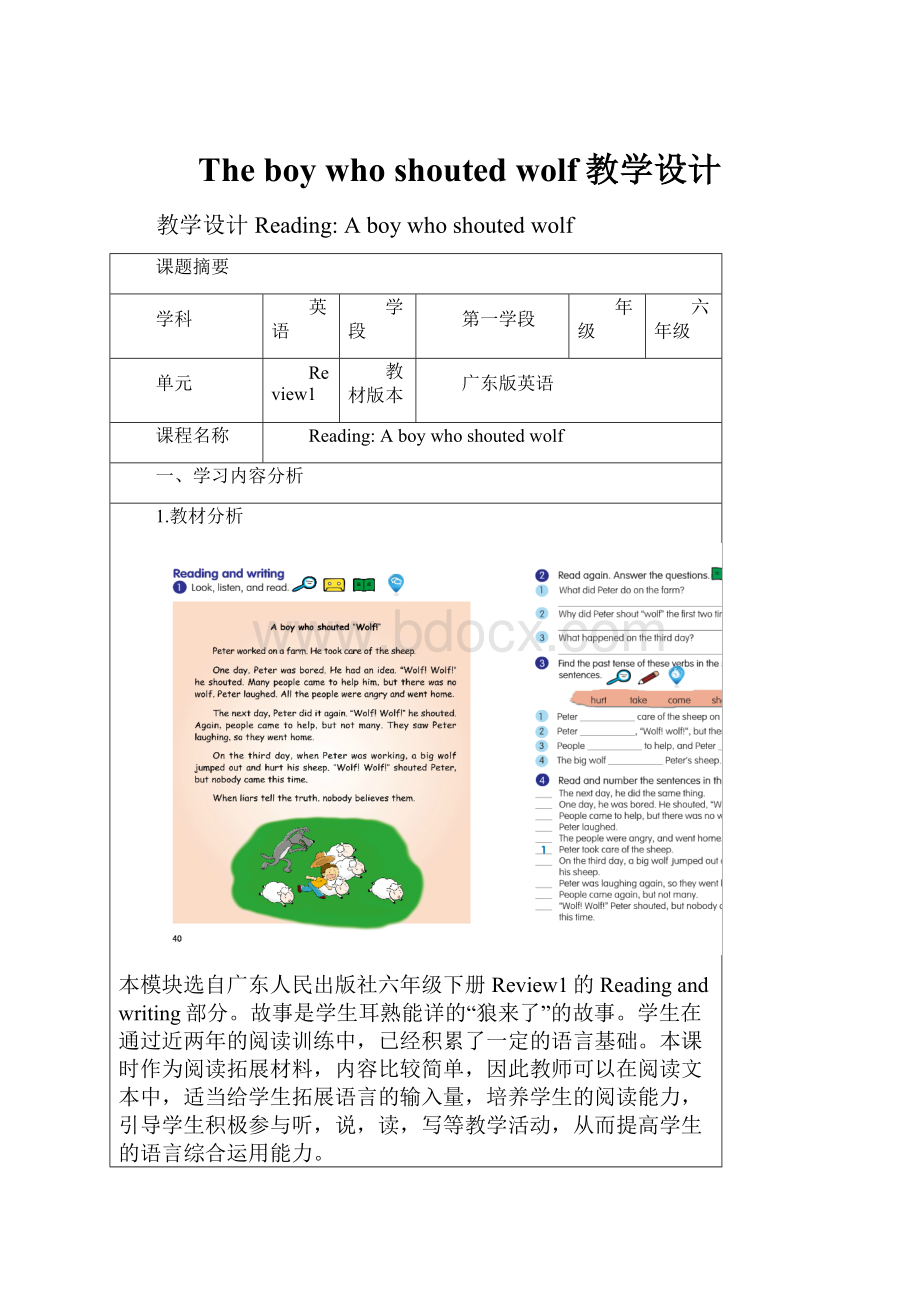The boy who shouted wolf教学设计.docx
《The boy who shouted wolf教学设计.docx》由会员分享,可在线阅读,更多相关《The boy who shouted wolf教学设计.docx(11页珍藏版)》请在冰豆网上搜索。

Theboywhoshoutedwolf教学设计
教学设计Reading:
Aboywhoshoutedwolf
课题摘要
学科
英语
学段
第一学段
年级
六年级
单元
Review1
教材版本
广东版英语
课程名称
Reading:
Aboywhoshoutedwolf
一、学习内容分析
1.教材分析
本模块选自广东人民出版社六年级下册Review1的Readingandwriting部分。
故事是学生耳熟能详的“狼来了”的故事。
学生在通过近两年的阅读训练中,已经积累了一定的语言基础。
本课时作为阅读拓展材料,内容比较简单,因此教师可以在阅读文本中,适当给学生拓展语言的输入量,培养学生的阅读能力,引导学生积极参与听,说,读,写等教学活动,从而提高学生的语言综合运用能力。
2.学情分析
1.学生年龄特点和认知特点分析:
本单元的学习对象是六年级学生,年龄约在11到12岁左右,他们具有较强的求知欲,对新鲜事物开始思考、追求、探索。
在好奇心的驱使下,他们对英语学习有着更高的兴趣和热情,在图片及教师的引导下,大部分学生的口语表达流利,能用所学知识进行简单的交流。
但对英语写作及自由表达的能力还有待加强。
2.语言知识和技能分析:
通过前面五年的英语学习,学生掌握和储备了一定的语言知识,并具有将所学习和掌握的知识运用于语言实践中的能力。
在学习本课之前,学生对过去时的表达已经比较熟悉。
3.学习能力分析:
在五年级和六年级上学期的阅读技巧,阅读策略培养下,学生已经掌握一定的阅读方法,有了一定的思维能力、分析能力和理解能力,对于用英语表达自己的一些意愿或思想也有一定的信心和能力,同时也具备用英语与他人合作与交流完成学习任务的能力。
在本单元的阅读教学中,老师将采用各种教学手段,帮助学生习得语言知识,获得语言技能。
3.教学目标(含重难点)
1.Knowledgeobjectives:
(1)Studentscangenerallyunderstandthemeaningofthestory.
(2)Studentscanapprehendthetruth“Don’ttelllies.”“Whenliarstellthetruth,nobodybelievesthem”stepbystepwiththehelpoftheteacher.
(3)StudentscandiscusswhathappenedtoPeterandgivesomeadvicetoPeter.
2.Abilityobjectives:
(1)Studentscangetthemainideaofthetextbyfirstreading.
(2)Studentscanfindoutsomenecessaryinformationbyskimmingandscanning.
(3)Studentscantalkandknowtheprinciple“Whenliarstellthetruth,nobodybelievesthem”fromthestoryandgetitbydiscussion.
(4)Studentscanmastersomeeffectivereadingstrategiesgradually.
3.Learningstrategies:
(1)Studentscanlearntousetheoldlanguagetolearnthenew.
(2)Studentscantakepartintheactivitiesactivelyinclass.
(3)Studentscancommunicatewithothersconfidently.
4.Emotionobjectives:
(1)StudentscanbeactiveandconfidentwhentheyexpressinEnglish.
(2)StudentscanbeinterestedinEnglishreadingbysomepicturesorotherteachingtools.
(3)Studentscanwidentheirvisionafterstudyingandknowthetruth“Don’ttelllies.”“Whenliarstellthetruth,nobodybelievesthem.”
Ⅳ.TeachingKeyPoints:
1.Studentscanknowhowthestoryhappenedbysearchingthedetailinformation.
2.Studentscanunderstandtheprinciple“Whenliarstellthetruth,nobodybelievesthem”byanalyzingthedetailinformationofthestory.
二、教学环境选择
□√简易多媒体教室□交互式电子白板□网络教室□移动学习环境
三、教学过程设计
教学环节
活动设计
信息技术使用说明
Step1:
Pre-reading
Step2:
While-reading
1.Leadin:
Doariddle.WhatanimalamI?
2.Askandanswer.
T:
Haveyoueverreadorheardanystoriesthatareabout“wolf”?
Itcanbeabook.Itcanbeastory.Itcanbeamovie.Whoknows?
Afteraskingandanswering.
T:
Look!
Thisisastoryabout“wolf”.
It’scalled“Thewolfiscoming”。
Thisisabookabout“wolf”.It’scalled
“Langwangmeng”.Thisisamoveabout“wolf”.It’scalled“Langtuteng”.
3.Showthestoryof“thewolfiscoming”inthewrongorderandguidethestudentstrytotellwhatstoryitis.
T:
Andhere’sastoryabout“wolf”,butit’sinwrongorder.Pleasetrytotellwhatstoryitis.
4.Showthestorythatwearegoingtolearntoday.
Afterstudentsguessingthestoryright.
T:
Yes,itis“Thewolfiscoming”.Andwecanalsocallit“Aboywhoshouted“wolf”.Thenwritethetitleontheblackboard.
Task1:
Skimming
Readandanswer.
T:
Whowasinthestory?
Wherewasit?
Whatdidhedothere?
Havestudentsreadthestoryquickly,andchecktheanswers.Thentellsomereadingtipstothestudents.
Task2:
Skimming
Studentsreadquicklyandfind:
1)HowmanytimesdidPetershout“wolf”?
2)Whydidheshout“wolf”forthefirsttwotimes?
Task3:
Scanning
Studentsreadcarefullyandfind:
HowdidPetertellliesandwhathappened?
T:
Peterwasbored,andheshouted“wolf”forfirsttwotimes.Onthefirstday,hehadanidea,andheshouted“wolf”.Onthenextday,hediditagain,andshouted“wolf”.Whatdidthepeopledoonthefirstdayandthenextday?
Whatwastheend?
WhatwasPeter’sfeelingonthefirstdayandthesecondday?
Whatwerethepeople’sfeelings?
(在引导学生自主阅读时,先引导学生整体寻读课文,找出第一、二天的相关信息,层层递进,通过提问:
Whywerethepeopleangryforthefirstdayandthesecondday?
生答:
Becausetherewasnowolf.进而引导出Petertoldalieonthefirstday.Petertoldalieagainonthesecondday.)
T:
Whataboutthethirdday?
(再通过第三天的信息寻读,在教师的引导下,学生能总结出“Hetoldthetruthonthethirdday,butnobodybelievedhim.”进而领悟“Whenliarstellthetruth,nobodybelievesthem”的道理。
)
Task4:
Discussion
T:
Whoisaliar?
(liar是一个新的词汇,学生可能不懂它的意思,但通过之前的渗透与理解,学生能猜出其意思,并能答出Peter是liar)
Task5:
Conclusion
T:
Whatcanwelearnfromthestory?
Task6:
Readthestorytogether.
Task7:
Trytoretellthestory.
1.Showthekeywordsandthepictures,andguidestudentstoretellwhathappenedinthefirstdaytogether.
2.Showpicturesandkeywordsandguidestudentstoretellwhathappenedonthesecondandthethirddayingroups,andaskseveralstudentstoretellinclass.
[设计意图:
用对等概念引入阅读教学,先出示相对应的文字让学生猜相应的动物,再用图片激活背景知识,培养学生思维能力。
]
[设计意图:
通过问答Haveyoueverreadorheardanystoriesthatareabout“wolf”,进一步激活学生有关狼的主题的故事或书或电影等背景知识。
]
[设计意图:
由于狼来了的故事学生耳熟能详,所以让学生通过打乱顺序的故事来猜今天学习的故事主题,是对学生思维和判断能力的训练。
再而引出“Thisstoryhasanothername.Wecanalsocalledit“Aboywhoshouted“wolf””.从而正式进入故事的学习。
]
[设计意图:
通过任务一的设计,让学生找出故事的主人公和故事发生的地点,用思维导图的形式呈现问题并让学生快速略读。
同时进行阅读策略的渗透:
Tips(阅读小技巧):
文章的首段通常会包含who,what,where,when等基本信息。
]
[设计意图:
通过任务二:
跳读,让学生快速找到关键信息:
Heshoutedwolfforthreetimes.并给出阅读技巧点拨:
阅读时,注意各段首的关联词或是表顺序的词,如Onday,thenextday,onthethirdday。
这样,训练学生抓住关键词,快速阅读文本,寻找关键信息的阅读技巧。
]
[设计意图:
本节课的内容是学生耳熟能详的故事,如果单单是让学生理解故事,看似简单。
但是如何组织信息,体现线索,让学生自己总结观点,复述课文,最终讲出Whenliarstellthetruth,nobodybelievesthem的道理,似乎也不简单。
所以,在设计时,利用表格呈现线索,如狼来的前后三次不同人物的动作、心情和结果的对比,引导学生自主阅读。
通过寻读,找出事件和人物心理发展线索,帮助学生理清阅读材料中的脉络,从而达到由表层到深层理解阅读语篇的目的,培养学生在文本中快速寻找信息的阅读能力和归纳总结经验的能力。
]
[设计意图:
教师根据板书通过引导,Oneday,Petertoldalie.Thenextday,hetoldalieagain.Onthethirdday,hetoldthetruth,butnobodybelievedhim.总结出Don’ttelllies!
和Whenliarstellthetruth,nobodybelievesthem的道理。
]
[设计意图:
通过任务六:
跟读,让学生在模仿中学习地道的语音语调,并在读的过程中,再一次回顾文本的内容。
]
[设计意图:
通过表格呈现故事线索,利用图片体现信息,让学生复述Peter第一天的经历,给接下来的第二、第三天的复述做出示范,减低复述的难度。
]
[设计意图:
有了第一次复述的经验,再通过表格的使用和图片的帮助,学生小组根据表格组织信息,进行复述。
进一步培养了学生英语思维能力、英语表达能力以及小组沟通合作能力。
]
Step4:
Post-reading
1.Peterreadastoryandlearnedsomethingfromit.
(1)Guidethestudentstolookatthestoryand
askthestudentstogiveatitletothestory.
T:
Peterwasverysadbecausenobodycametohelphim.Andhereadastorythatnight.
(2)ShowthestoryAboywhoshouted
“Help”,andhavestudentschoosetherightwordstofinishthestory.
(3)Checktheanswers.
(4)Discussion:
WhatcanPeterlearnfromthisstory?
2.WhathappenedtoPeteratlast?
ShowthepassageaboutwhathappenedtoPeteratlast,andguidestudentstodiscuss:
(1)DidPetertellliesagain?
(2)Didthepeoplecometohelphimwhenthewolvescameagain?
(Thepassage:
Peterwasreallyverysadbecausenobodycametohelphim.Fromthenon,hetriednottotellliesandbeagoodboy.Andheboughtsomesheepagain.
Hebegantohelpothers.Gradually(慢慢地),peoplechanged(改变)theirthoughtsaboutPeter.TheythoughtPeterwashonestandhelpful.
Oneday,Peterwasworkingasusual.Suddenlytherecametwowolves,heshoutedloudly"Wolf,wolf!
".Peopleheardit,andtheyrantothetophilltohelpPeterchasethewolvesaway.
Sincethen,Petertookcareofthesheephappily,andhegotalongwellwiththefarmers.Theylivedhappilytogether!
)
[设计意图:
拓展材料紧扣主题,利用Peter因为撒谎导致真正遇到困难时没人帮助他,很伤心,然后恰好读了一个相关的小故事,从而期待他从故事中和自我经历中吸取教训,改变自我,为下面的进一步的Peter的行为可能得到改变埋下伏笔。
同时,在Ben和Tom的故事中,有效检测了本节课的重点词汇。
]
[设计意图:
本环节是拓展的阅读内容。
紧扣故事的发展线索,给Peter的故事创造一个happyending,进一步训练了学生的阅读能力,也给学生带来正能量的思想教育。
]
Step4:
Homework
1.ReadtheendingstoryaboutPeteragain.Andfinishtheexercise.
Trueorfalse.
1)Peterdidn’t’tbuyanysheepafterhissheepwaseaten.()
2)Peterchangedandbecamehonestandhelpful.()
3)Petertookcareofthesheephappily,buthecouldn’tgetalongwellwiththefarmers.()
[设计意图:
让学生把阅读材料作为课后阅读补充,进行细节阅读,进一步训练学生的阅读能力。
]
四、教学评价设计
1.评价方式与工具
□√课堂提问□√书面练习□制作作品□测验□√其它
2.评价量表内容(测试题、作业描述、评价表等)
练习
(一)
练习
(二)
WhathappenedtoPeteratlast?
一.Readanddiscuss(阅读并讨论):
1.DidPetertellliesagain?
2.Didthepeoplecometohelphimwhenthewolvescameagain?
二.Trueorfalse(判断对错).
1.Peterdidn’tbuyanysheepafterhissheepwaseaten.()
2.Peterchangedandbecamehonestandhelpful.()
3.Petertookcareofthesheephappily,buthecouldn’tgetalongwellwiththefarmers.()
五、备注
技术环境下课堂教学管理思路、可能存在的教学意外及相应的应急预案等。
备注:
本模板仅供参考,参训教师可根据实际情况,自行修改创新。